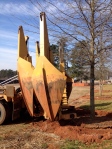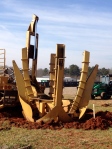I drove by this tree transplanter for several days before I got to see the contraption at work. A South Carolina-based team received a large-sized grant from the University of Georgia to plant trees throughout the campus over the course of a year. They’re at around 1,000 now…mostly oaks. Makes me wonder where.
UGA has traditionally kept immaculate grounds while maintaining storied shade. Nevertheless, since my college days here, lawns and grassy or vacant spots have disappeared. So much of the green space has been taken over by awkward-looking, chunky McBuildings. These monstrosities are far too big for their respective lots. What’s more, their boxy structures can only mean that the sites were clear cut.
In this case, the land was for as long as I can remember a field, possibly a cotton one, as Athens was once a key brokerage center for the southern commodity. The row here stands in front of what will next year be the university’s new $105 million Veterinary Teaching Hospital. (“Equine Teaching Unit” once marked an entrance, but the sign is gone, and there’s no replacement.) Perhaps they haven’t figured out what to call it yet or are waiting to honor a major donor with naming rights. Some fortuitous timing in this Chinese year of the horse!
Big John lifts a 10,000-pound root ball. That’s mega dirt! The tines nudge closer and closer together, disappearing into the earth. In a matter of minutes, the four steel arms cradle the red clay in a tightly closed tulip form and raise the entire plug onto the lift bed. The guys then truck this off to a nearby tree farm where it is swapped out for a newbie. Hydraulics are amazing.








